Social and Behavioral Science
138 Modern and Prehistoric Geospatial and Climatic Analysis of Aksumite Empire Site on the Tigray Plateau
Talon Roberts and Mitchell Power (Geography)
Ethiopia and the horn of Africa are well known for their vast history of human activity. This history includes some of the oldest hominid remains and ancient civilizations that have come and gone through time, including the Aksumite Empire. This research strives to better understand the environmental and anthropogenic history of the Aksumite Empire through developing a modern baseline from recent climate and geospatial data in the horn of Africa and comparing that data with long-term paleoclimate archives. This research will explore linkages among climate and fire history from sedimentary charcoal samples collected in 2019 near the city of Adigrat, Ethiopia. Specifically, to investigate what factors may have ultimately led to the collapse of the Aksumite Empire around 700 C.E. A sedimentary archive was used to document environmental changes associated with the development of ancient Aksumite farmlands, where both natural and intentional burning likely occurred. Through examining current climatic data in the horn of Africa and comparing it with long-term paleoclimate reconstructions (e.g., Lamb et al. 2007; Terwilliger et al. 2011) and a newly created sedimentary-charcoal fire history, this research aims to better understand factors that contributed to the decline of the Aksumite Empire. Specifically, this research explores whether natural environmental factors, anthropogenic factors (e.g., over-exploitation of resources), or potentially a combination of several factors contributed to the demise of the Aksumites.
INTRODUCTION
Roughly 2000 years ago, the Aksumite empire was one of the most influential and powerful ancient civilizations of its time. The Aksumites were highly recognized by the likes of the Roman Empire, the Egyptians, and the Greeks, largely due to their high involvement in the trade market and their proximity to the Red Sea (Mokhtar, 1981). This high involvement in the trade market promoted large scale agriculture and material production, and thus rapid advancement and empire expansion. The Aksumite’s were also one of the early adopters of Christianity, which highly influenced their culture and architecture. However, the Aksumite Empire’s reign mysteriously ended, and the exact cause for the collapse of the Empire after centuries of success remains a topic of debate. There are many hypotheses that argue the collapse was linked to natural environmental variability in the region, which may have negatively affected their food and supply chains. Other studies have argued that overpopulation mixed with overuse and overreliance on natural resources depleted the land, which could have caused widespread famine (Selassie, 2011) in the region and led to increased tension in the trade market.
Today, people occupy much of the area that was once associated with the Aksumite people, with most of the regional politics during Aksumite times relying heavily on agriculture production to fuel the empire. In this region, natural environmental processes and people’s agriculture practices are highly dependent on seasonal variations via the Intertropical Convergence Zone (ITCZ) (Hoegh-Guldberg et al., 2021) and the Indian Ocean Dipole (IOD) (Dubache et al., 2019). The ITCZ is a region near the equator that creates an upwelling effect of moisture from the Indian Ocean. As the Earth’s axial tilt changes throughout the year, the ITCZ moves north and south, creating wet and dry seasons. Because of Ethiopia’s geographic location residing slightly north of the equator, this region typically experiences one significant rainfall season per year, with the rest of the year receiving minimal precipitation. In addition, because the area relies heavily on the limited wet season, shifts in the climate, including an expansion of the dry season, can vastly affect crop production. With that said, modern climate change today has already negatively affected this area, as extreme rain and flooding mixed with prolonged, severe drought have dramatically affected people, crop production, and natural ecosystems (Niang et al., 2018).
With such a sensitive ecosystem in place in the Horn of Africa, I hypothesize that drought mixed with overexploitation and overreliance of natural resources led to the rapid decline of the empire. Drought is known to be a large contributor to wildfires, and because there is limited natural vegetation left in the Adigrat area today, I also hypothesize that the intentional burning and land clearing techniques used by the Aksumites could have increased the frequency of wildfires. The role of Aksumites amplifying natural fire regimes coupled with prolonged drought would have further strained the agricultural systems and capacity for people to thrive in this environment. Because the population was large and highly active in the trade market, any large environmental disturbance, such as drought for even a brief period would have severely affected both food production and the overall health of the Aksumites, ultimately leading to the collapse of trade and the Aksumite Empire.
METHODS In The Field
In 2019, Dr. Mitchell Power extracted sediment core samples from a dry riverbed located in the Kilat Valley near Adigrat, Ethiopia. Using the Horn of Africa as a whole for the geospatial and climatic analysis component of this paper, the Kilat Valley sediment core location on the Tigray Plateau is used to help discern the patterns seen through my geospatial and climatic analysis. It is in these sediment core samples that we can search for evidence of either natural wildfires or intentional agricultural burning through the documentation and frequency of charcoal throughout the sediment core samples.
Figure 1. Study site. The Tigray Plateau is a region of mountainous terrain that is much higher in elevation than the surrounding areas of Ethiopia. The city of Adigrat, as well as the city of Aksum, west of Adigrat and named after the Aksumite people, are both located in this region.
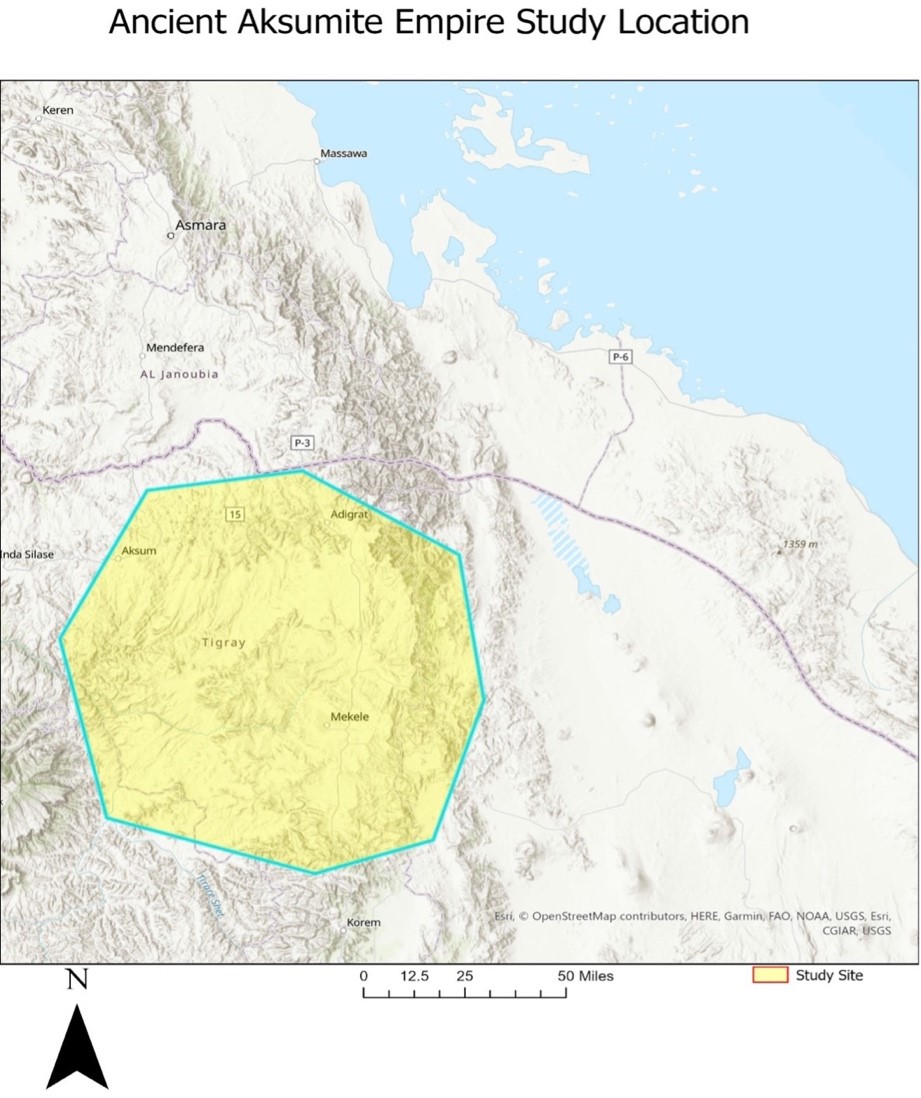
Figure 2. Map of the Horn of Africa in reference to the study site.
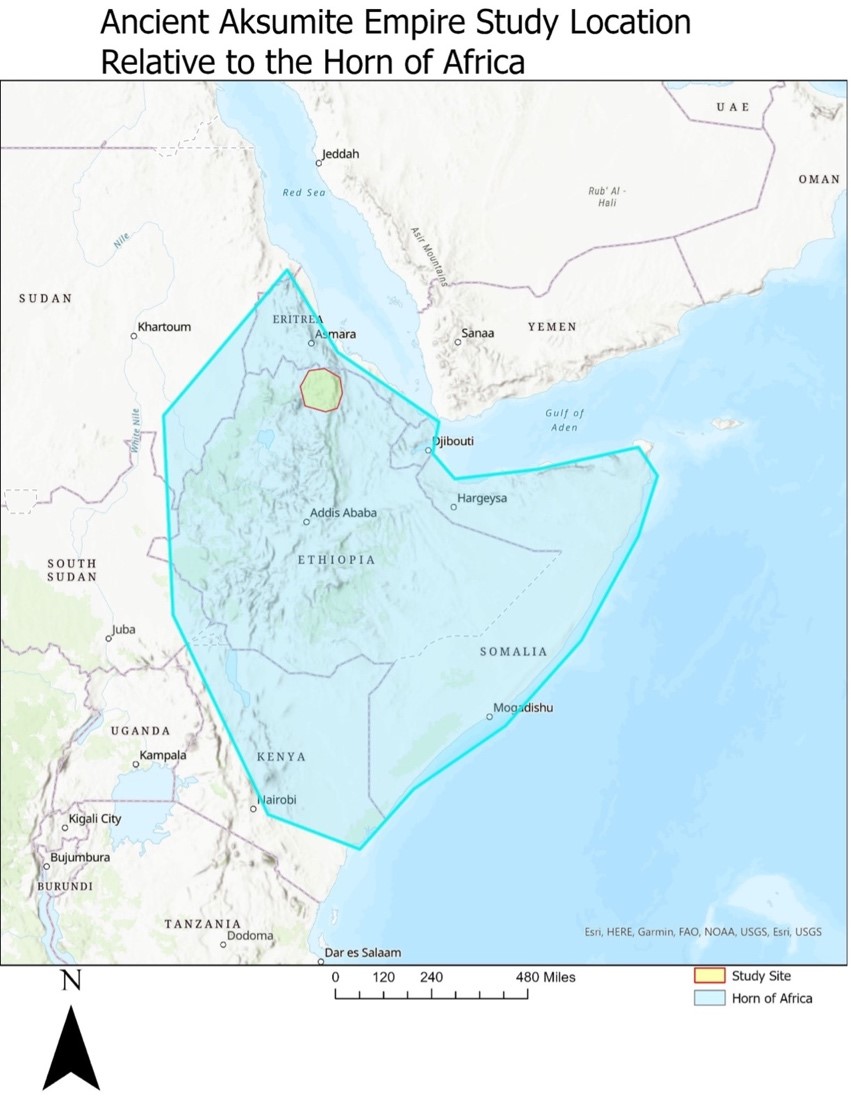
RESULTS AND DISCUSSION
Figure 3. Charcoal influx (charcoal particles cm-2 yr-1) on the top row, and Fire Frequency (number of discrete charcoal peaks per century) on the bottom row. The left time series represents 1160-1600 cal yr BP, a period of maximum population of the Aksumites) and the right time series represents ~3800-4040 cal yr BP, a time prior to the arrival of Aksumites into the region.
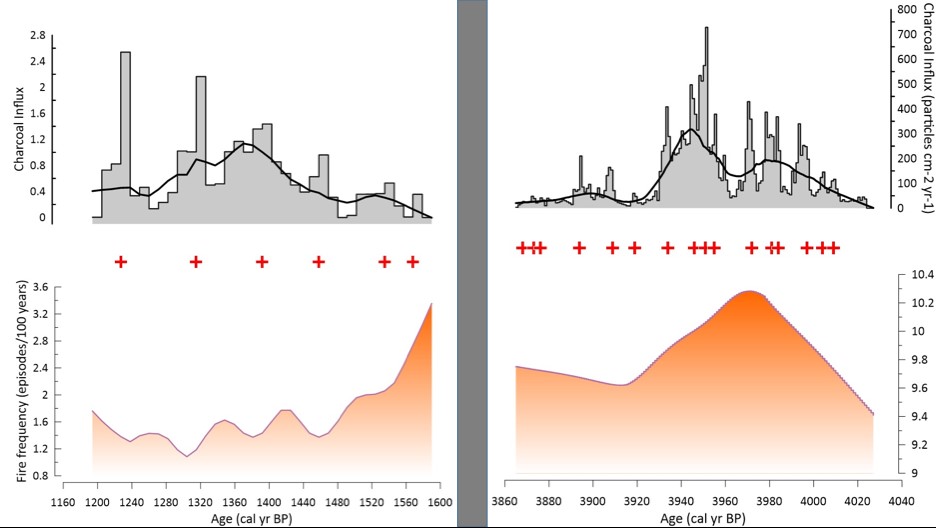
We analyzed three sediment cores for this study. The first two sediment cores represent data from approximately ~3800-4040 cal yr BP, with this period likely predating notable human settlement and land alteration. With the region of study hosting Afromontane forests, data from our sediment core analysis contained high charcoal influx. This suggests that high magnitude fires were frequent during this time, possibly from natural wildfires in these Afromontane forests. These fires were occurring at about 1 fire every 10 years, with the largest occurring in 2000 BCE (Fig. 3).
The third sediment core represents the time frame of ~1160-1600 cay yr BP, which largely spans the 400-year period that marks the peak of the Aksumite Empire. Through analysis of this sediment core, we found a significant decrease in charcoal influx and about 1/3 as much fire activity compared to previous times. There were 6 notable fire events, and they occurred at an approximate rate of 1 fire every 50 years (Fig. 3). However, further analysis must be conducted to discover what conditions were present during the presumed Empire collapse date of 700 C.E.
Figure 4. Low resolution charcoal influx and fire frequency graph over approximately 3500 years in Adigrat, Ethiopia.
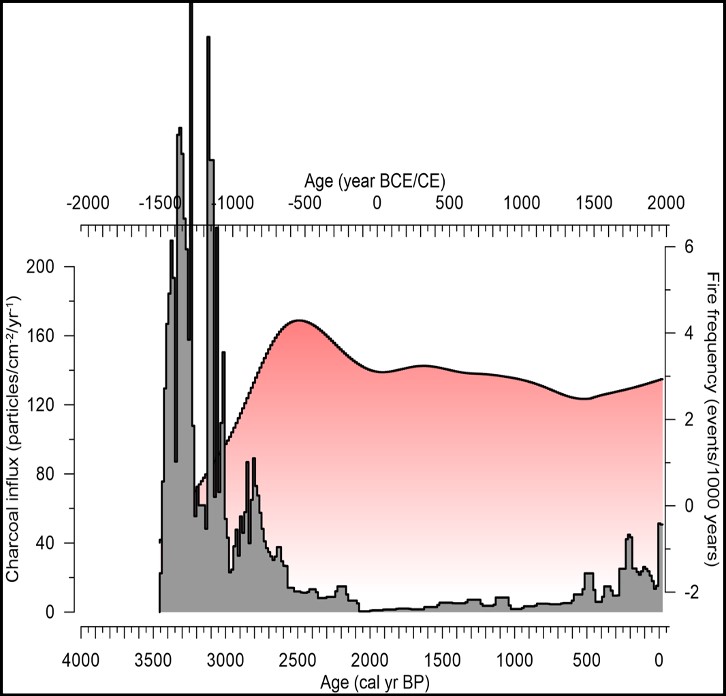
Figure 5. Map of the ITCZ in reference to the Horn of Africa and the study site.
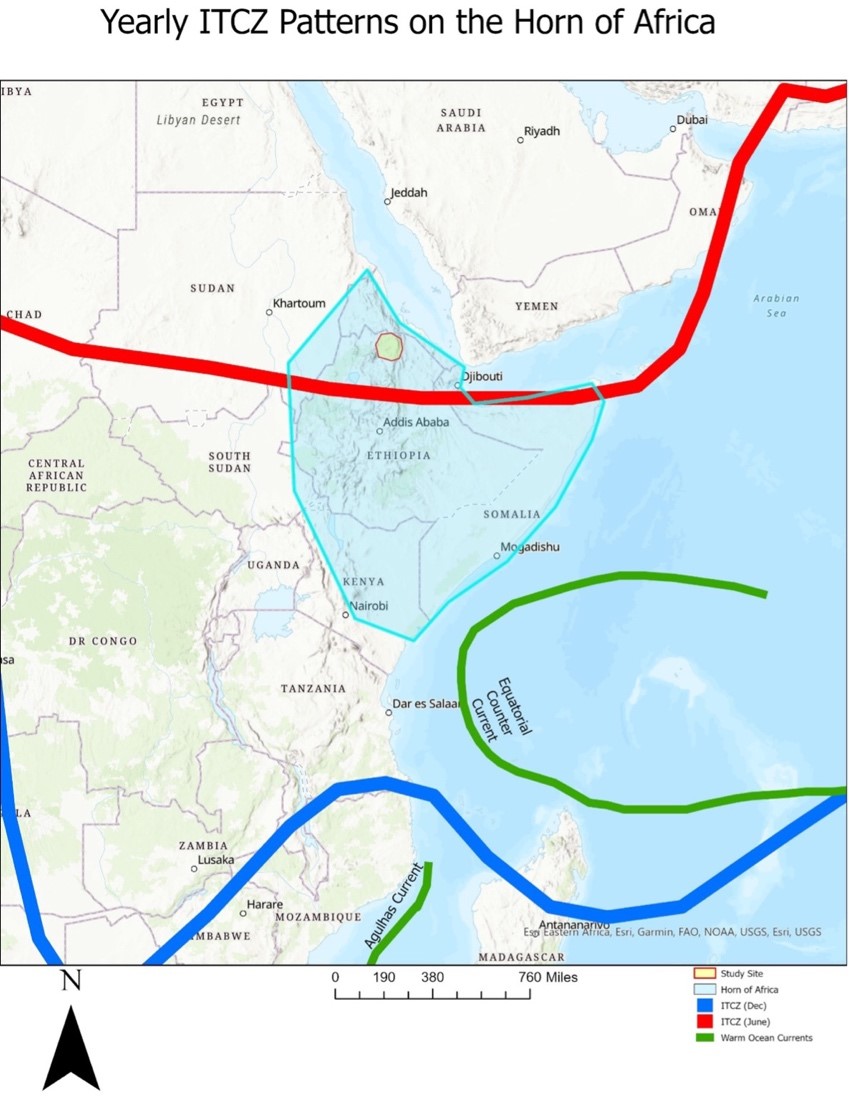
Figure 6. Map of Vegetation Anomalies throughout the Horn of Africa.
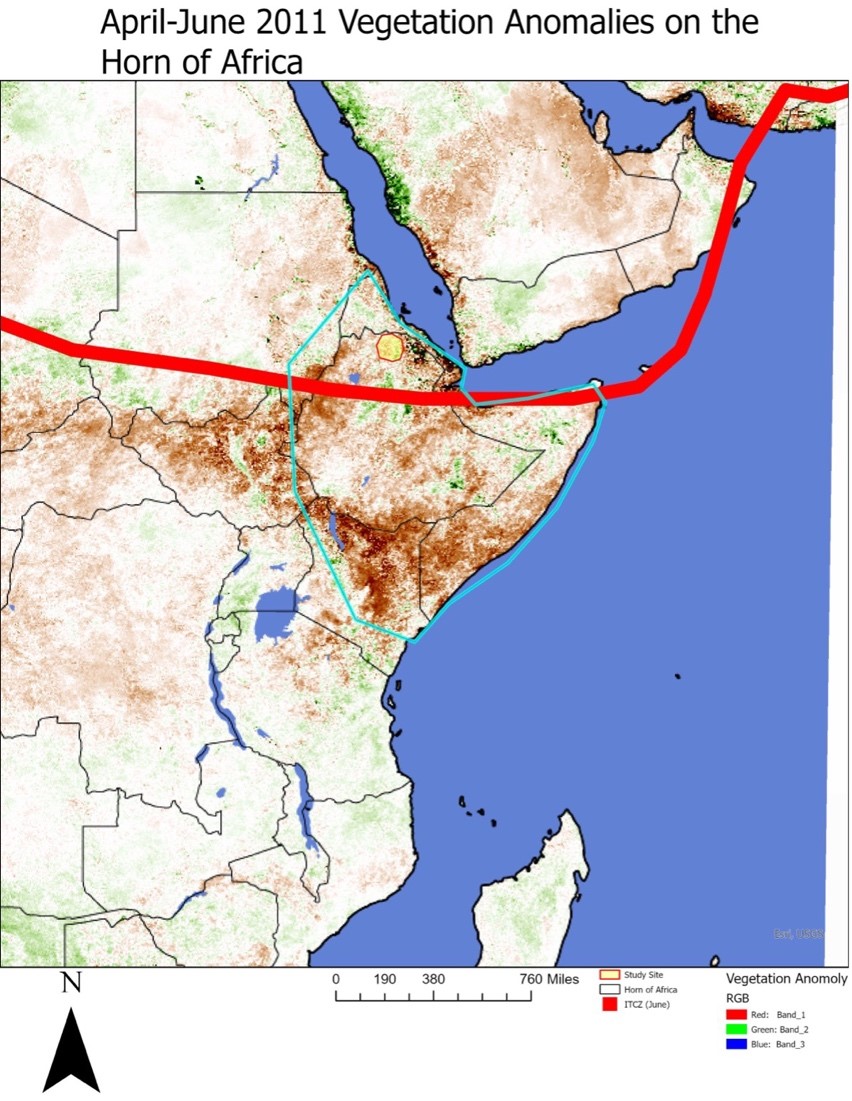
As we can see from the vegetation anomaly (Figure 6) taking place from April-June 2011, the ITCZ is situated at its peak latitude position, leading into what should be the average annual heavy rain season. However, what was supposed to be the start of the rainy season in March and April of 2011 yielded limited precipitation, leading to poor vegetation growth. “The crop grown during this period is typically planted in March or April, when the first rains of the year fall. In 2011, the rains were late, falling in late April and May, and inadequate (Nasa Earth Observatory, 2011).” Late 2010 also saw little rain in the region.
Figure 7. Rainfall anomalies in the Horn of Africa.
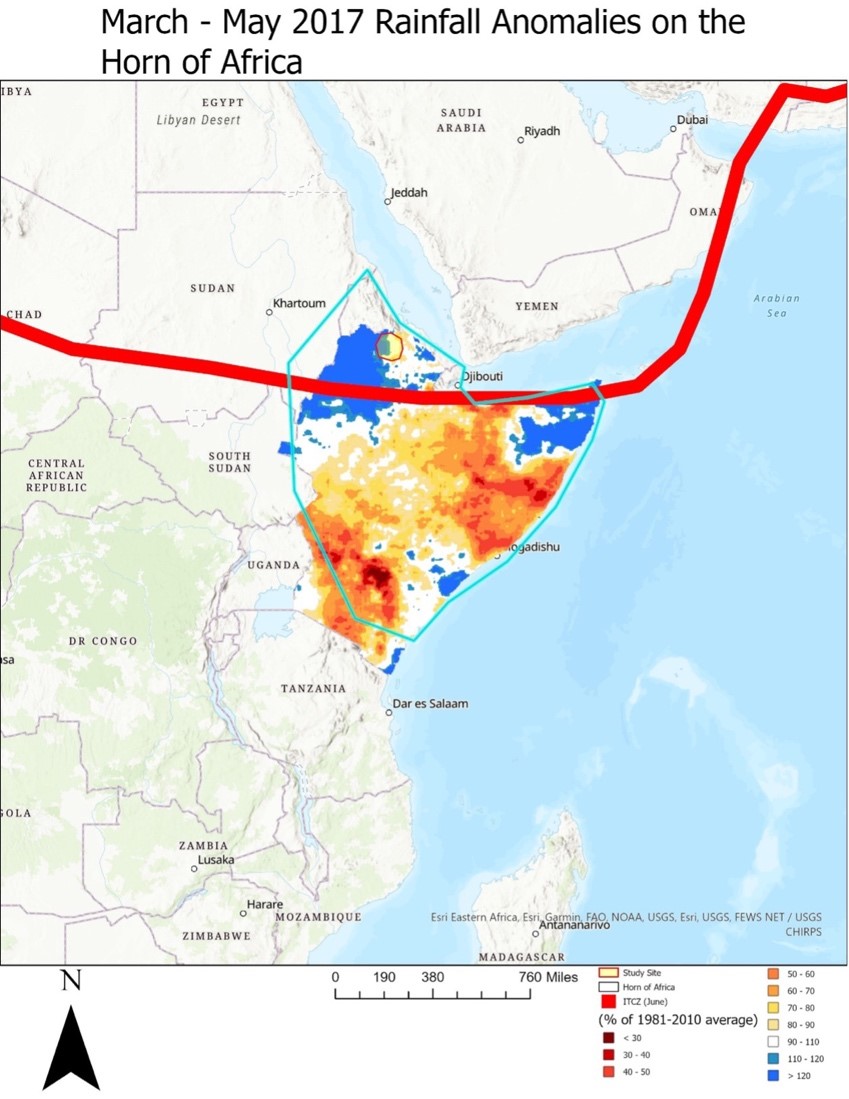
Similarly in 2017, we see more anomalies in Figure 7. However, Figure 7 depicts rainfall anomalies from March – May 2017, showing where exactly rainfall is occurring in the Horn of Africa. About half of the study site’s area was experiencing less than normal rainfall, whereas the rest of the Horn of Africa was experiencing very minimal rainfall. With rainfall being vital to the planting of crops early during the start of the rainy season in March, this lack of rainfall devastated the area. “The strongest El Niño phenomenon on record led to an extreme drought in 2016, with 10.2 million in need of food aid (Anyadike, 2017).”
Figure 8. Map of the ITCZ and its continental effect on rainfall. The Horn of Africa typically receives a small window of opportunity for rainfall. The southwest, central, and southeast portions of Africa receive much more rainfall than the northern section of Africa. This further highlights the importance of an adequate rainy season in the Horn of Africa.
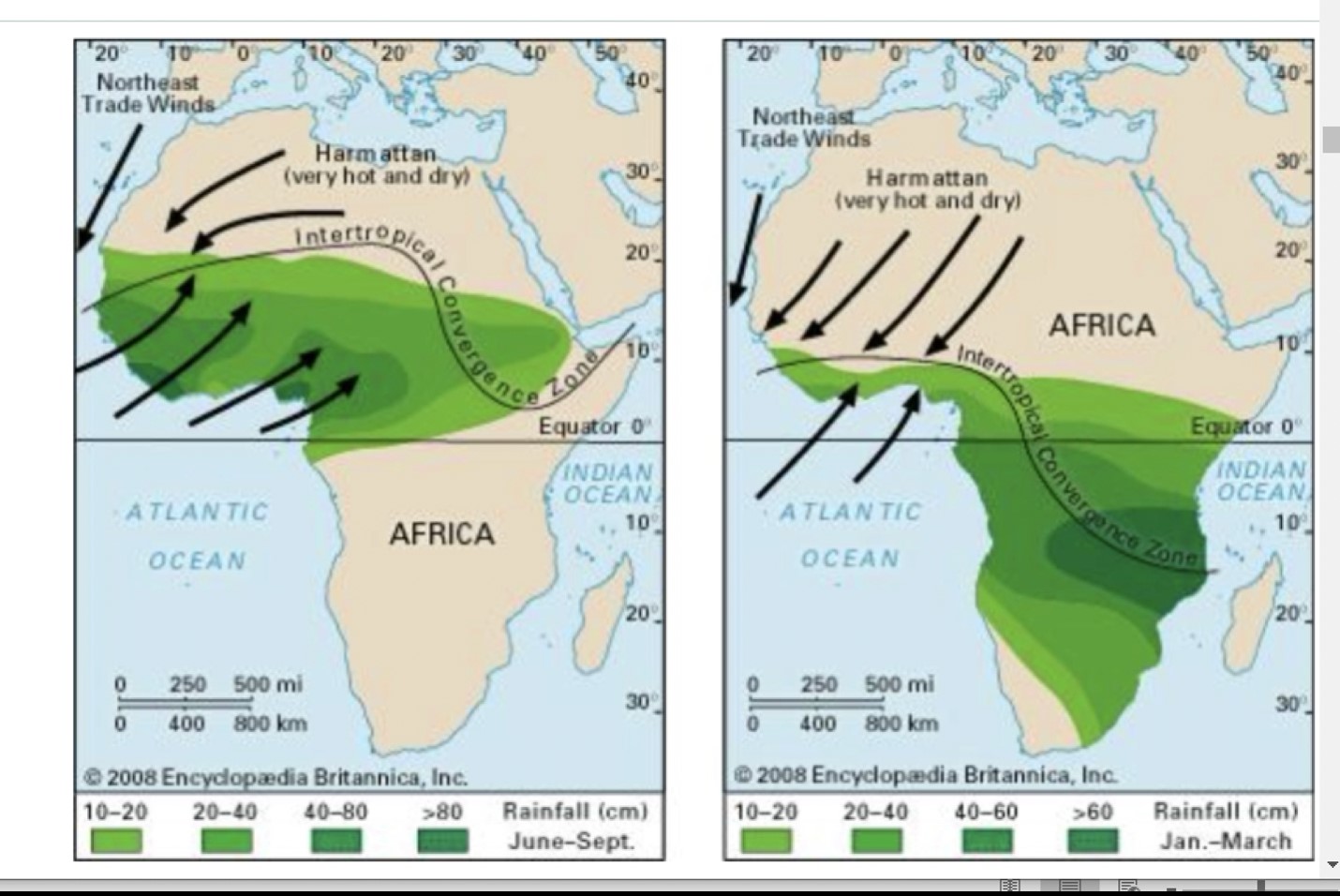
Figure 9. 3-Month Standardized Precipitation Index on the Horn of Africa.
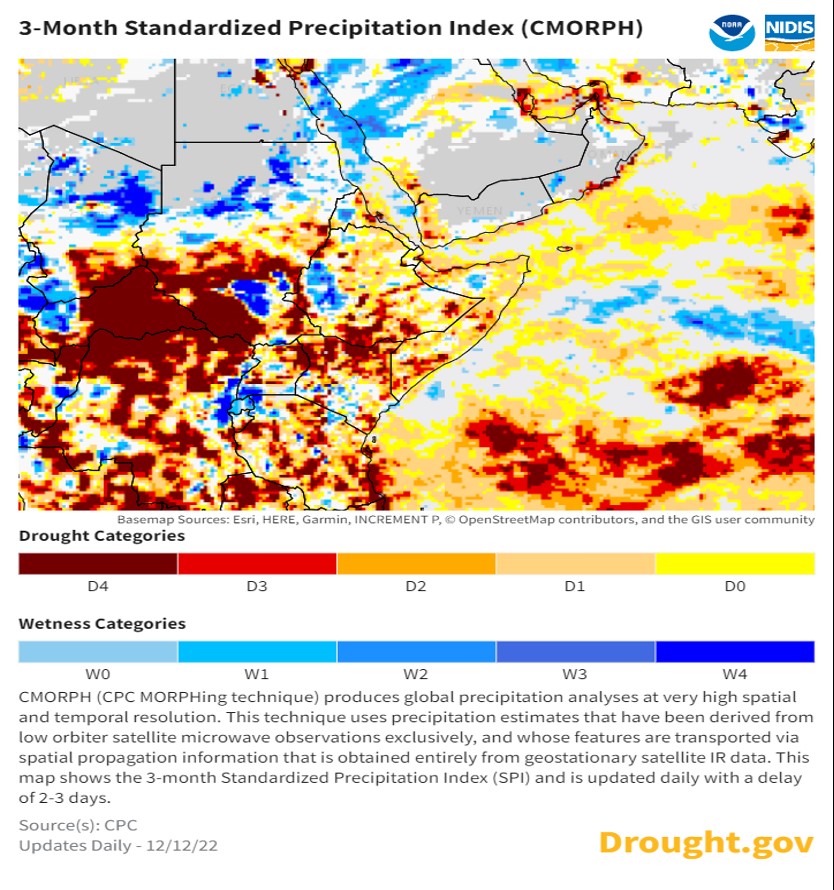
Data from the modern geospatial and climatic analysis of this study shows that drought has been ravaging much of the Horn of African for over a decade, as seen through both rainfall analysis and vegetation anomalies (Figure 6,7, and 9). With climate change undoubtedly underway, changes to the IOD can be a possible contributor to recent ITCZ fluctuations, with La Niña being one of the main drivers for changes in the Indian Ocean Dipole and the ITCZ. “ENSO – La Niña – causes drier than average conditions in the long rainy season (Jimenez, 2021).” Seeing how climatically sensitive this region is, it also supports my research on finding evidence on a possible climate change induced collapse of the Aksumite Empire. Continued paleoclimatology analysis and research is needed to further support this hypothesis.
However, drought conditions in the Horn of Africa are not new, as the region has been experiencing intense droughts on and off for over 40 years. “Parched ground tells the story of the past 40 years with rainy seasons continually failing in the country (Wentworth, 2022).” Funk et al. also states that, “We present analyses suggesting that warming in the central Indian Ocean disrupts onshore moisture transports, reducing continental rainfall. Thus, late 20th-century anthropogenic Indian Ocean warming has already produced societally dangerous climate change by creating drought and social disruption in some of the world’s most fragile food economies (Funk et al., 2008).”
After analyzing how climatically sensitive this region is, fluctuations in the ITCZ and IOD appear to be prominent evidence for explaining a possible climate change induced collapse of the Aksumite Empire. It may be possible that my hypothesis about environmental impacts affecting the Aksumite Empire’s collapse, particularly with fluctuations in the IOD and ITCZ, may apply to what is currently occurring in the region today. Facing an array of drought and civil war issues, thousands of people are at risk of starvation, and there have been patterns of drought and flooding that have highly affected the region in the recent past. As stated by the Famine Early Warning Systems Network, “The population in need of humanitarian food assistance in Ethiopia has reached record levels [1] in 2022 – 10 to 15 million people – driven by ongoing insecurity and climate shocks that are likely to result in continued high needs into 2023 (FEWS NET, 2022).”
CONCLUSION AND FUTURE WORK
The prominent role of drought across the Horn of Africa has been linked to natural variation in the ITCZ. Previous work has suggested that changes to the IOD can be one of the biggest drivers impacting the seasonal rainfall associated with the ITCZ. Specifically, during La Niña events, changes in the IOD have been linked to changes in the ITCZ. The role of ENSO variability, particularly during the La Niña phase, causes drier-than-average conditions during the typically lengthy rainy season (Jimenez, 2021). The high climatic sensitivity of this region also supports this research on finding a possible climate change induced cause of the collapse of the Aksumite Empire. A relevant historic climatic event to this study is the Medieval Warm Period event, which occurred within the first few hundred years (~950-1200 CE) after the Aksumite Empire vanished. Changes in charcoal influx are evident during this time, suggesting a potential natural forcing in addition to human-environment changes caused by the Aksumites. Curiously, this also closely coincides with the fall of the Mayan empire at approximately 860 CE, another civilization that may have had a similar relationship with the ITCZ (Brunelle, 2022). Continued paleoclimatology research and geospatial analysis is needed to further support this hypothesis.
It is still unclear the degree to which fluctuations with the ITCZ and IOD may have contributed to the demise of the Aksumite empire. However, it is clear the ITCZ and IOD play a significant role in the region’s climate today. Since agriculture in the Horn of Africa still heavily relies on seasonal rainfall, better understanding past and modern shifts to the ITCZ and IOD may play a vital role for climate change prediction and preparation. By better understanding both past and the present climate data, we can better model and predict how climate may function, change, and affect us in the future.
AKNOWLEDGEMENTS
My research is a part of Dr. Mitchell Power’s larger Ethiopia Project, which consists of multiple studies conducted by several other students and researchers. Dr. Mitchell Power has been a great mentor, both academically and in the lab. I am grateful for the chance to work with him and the trust he has in me to conduct research for him. His charisma, enthusiasm, and passion for research rub off on everybody who works with him, including myself. He has inspired me to continue pursuing academics and conducting research, and I am thankful to have been a part of his Research. I would also like to thank my colleagues Miranda Clow and Corinna McMurtrey, who also both worked on separate studies for Dr. Power’s Ethiopia project. Both Corinna and Miranda provided great support, enthusiasm, and kinship throughout my research process. A special thanks goes out to Corinna, who told me about Dr. Power’s Ethiopia Project and invited me to participate in one of their meetings, which led to me eventually joining the project. Lastly, I would like to thank the Office of Undergraduate Research and the Wilkes Center for Climate Science and Policy for giving me the opportunity to conduct this research. Without their support and funding, conducting this research as an undergraduate student at the University of Utah would have been nearly impossible for me. I learned a great deal through this research, both from the insights and experiences I gained from conducting research and from working with others.
REFERENCESNiang, I., O.C. Ruppel, M.A. Abdrabo, A. Essel, C. Lennard, J. Padgham, and P. Urquhart, 2014: Africa. In: Climate Change 2014: Impacts, Adaptation, and Vulnerability. Part B: Regional Aspects. Contribution of Working Group II to the Fifth Assessment Report of the Intergovernmental Panel on Climate Change [Barros, V.R., C.B. Field, D.J. Dokken,
M.D. Mastrandrea, K.J. Mach, T.E. Bilir, M. Chatterjee, K.L. Ebi, Y.O. Estrada, R.C. Genova, B. Girma, E.S. Kissel, A.N. Levy, S. MacCracken, P.R. Mastrandrea, and L.L.White (eds.)]. Cambridge University Press, Cambridge, United Kingdom and New York, NY, USA, pp. 1199-1265.
Hoegh-Guldberg, O., R. Cai, E.S. Poloczanska, P.G. Brewer, S. Sundby, K. Hilmi, V.J. Fabry, and S. Jung, 2014: The Ocean. In: Climate Change 2014: Impacts, Adaptation, and Vulnerability. Part B: Regional Aspects. Contribution of Working Group II to the Fifth Assessment Report of the Intergovernmental Panel on Climate Change [Barros, V.R., C.B. Field, D.J. Dokken, M.D. Mastrandrea, K.J. Mach, T.E. Bilir, M. Chatterjee, K.L. Ebi,
Y.O. Estrada, R.C. Genova, B. Girma, E.S. Kissel, A.N. Levy, S. MacCracken, P.R. Mastrandrea, and L.L.White (eds.)]. Cambridge University Press, Cambridge, United Kingdom and New York, NY, USA, pp. 1655-1731.
Dubache, G., Ogwang, B. A., Ongoma, V., & Towfiqul Islam, A. R. M. (2019, December). The effect of Indian Ocean on Ethiopian seasonal rainfall. NASA/ADS. Retrieved June 30, 2022, from https://ui.adsabs.harvard.edu/abs/2019MAP… 131.1753D/abstract#:~:text=Further%20anal
ysis%20reveals%20that%20there,Kenya%2C%20South%20Sudan%2C%20and%20wester n
Terwilliger, V. J., Eshetu, Y. Z., Huang, M., & Alexandre, M. (2010, September 16). Local variation in climate and land use during the time of the major kingdoms of the Tigray Plateau in Ethiopia and Eritrea. CATENA. Retrieved June 30, 2022, from https://www.sciencedirect.com/science/article/pii/S0341816210001232?casa_token=al- fZ5_P1ocAAAAA%3AubSt283gai09V1TWxJu9flPw6Mi23lmNUuFvBHKIMbQ9YD7M
Lam, H. F., Leng, M. J., Telford, R. J., Ayenew, T., & Umer, M. (2007, May 1). Oxygen and carbon isotope composition of authigenic carbonate from an Ethiopian lake: a climate record of the last 2000 years. The Holocene. Retrieved July 1, 2022, from https://www.researchgate.net/publication/37146725_Oxygen_and_carbon_isotope_compos ition_of_authigenic_carbonate_from_an_Ethiopian_lake_A_climate_record_of_the_last_2 000_years
Selassie, Y. S. G. (2011). Plague as a possible factor for the decline and collapse of the …
Plague as a Possible Factor for the Decline and Collapse of the Aksumite Empire: a New Interpretation. Retrieved July 1, 2022, from http://www.ityopis.org/Issues- 1_files/ITYOPIS-I-Gebre-Selassi.pdf
Mokhtar , G. (1981). General history of Africa, II: Ancient civilizations of Africa.
Unesdoc.unesco.org. Retrieved June 30, 2022, from https://unesdoc.unesco.org/ark:/48223/pf0000184265
Jimenez, Abygail, Kenya Creer, and Valerie Radford. (December, 2021). “A Tale of Two Droughts.” https://storymaps.arcgis.com/stories/c552d8e2e94544b2a607f1fcee749592
NASA. “Severe Drought Causes Famine in East Africa.” Earth Observatory. Last modified July 23, 2011. https://earthobservatory.nasa.gov/images/51411/severe-drought-causes famine- in-east-africa.
Wentworth, Adam. “Drought is hitting Ethiopia harder than ever.” Climate Home News. Last modified October 27, 2022. https://www.climatechangenews.com/2022/10/27/drought- ishitting-ethiopia-harder-than-ever/
Anyadike, Obi. “Drought in Africa 2017.” The New Humanitarian. Last modified March 2017. https://www.thenewhumanitarian.org/feature/2017/03/17/drought-africa-2017.
Rabarad_FEWSNET. “MAM_Rainfall_Anom.” ArcGIS Online. Last modified July 11, 2017. https://www.arcgis.com/home/item.html?id=841db414a86f40bda7e7da14f759f59e.
NOAA. “National Integrated Drought Information System.” Drought.gov/international. Last modified December 14, 2022. https://www.drought.gov/international.
Rahamat, Mohamed Osman. “African Tropical Climates_WFL1.” ArcGIS Online. Last modified April 23, 2022 https://www.arcgis.com/home/item.html? id=b4febf65401a4ee5b63a14b41ac95a9f.
Brunelle, A. (Presenter). (2022) Module 16 Lecture Transcript. Speech presented at the University of Utah, Salt Lake City, UT, Uni

